

In this list of Amanita species, there are now
95? taxa of which
63? appear to be
undescribed in the literature. A. pantherina
is undoubtedly based on an incorrect determination found in older literature. A few European
species have been found to be in the northern part of the range of this
checklist (for example A. muscaria, A. regalis, and
A. porphyria).
As noted in the bibliography, we had the
privilege of access to unpublished M.Sc. theses of G. J. Breckon and N.
Nakamura and to the Amanita portions of manuscripts of A. H. Smith
The many collectors who have shared material with are credited on a
collection-by-collection basis in the material examined data fields of
technical tabs for individual species on the Amanitaceae Studies
website (here).
Photo credits not given on this page are to be found on individual
species pages.
With regard to supraspecific taxa: (Corner and Bas, 1962), (Bas, 1969), and (Gminder, 1994).
Genus Amanita
(They type genus of the family Amanitaceae idenitifiable by a sterile gill margin and a cap without slime)
Subgenus Amanita
(Spores inamyloid.)
Section Amanita
(Stipe bearing a basal bulb. NOTE: Do not confuse with cupulate volval remains
on nonbulbous stipe base.)
[ sectional links ]
[ top ]
[ meaning of biometric variables ]
[ bibliography ]
[ Amanita Studies home ]
[ checklists & keys page ]
Amanita albopantherina G. Wright nom. prov.
Loc.: CA
Lit.: [G. Wright ms.]
Spores: “8.2 - 9.5 × 5.8 - 6.6 μm, (Q = 1.43), inamyloid, ellipsoid.”
Pileus 45-55 mm wide, white to pale brownish; universal veil as a short membranous limb encircling the stipe base.
Amanita alpinicola Cripps & J. Lindgr.
Loc.: CA, MT, OR
Lit.: [Cripps & Lindgrer 2017; A. H. Smith Ms.]
Spores: “9 - 12 × 6 - 7.5 μm,” with Q approx. 1.55
Pileus 30-90 mm wide, pale yellow to cream color but in age often whitish,
finally discoloring brownish; universal veil as a free-margined volva that is
not inrolled, Stipe rapidly becoming exannulate.
Amanita ameripanthera Tulloss nom. prov.
Loc.: BC CA WA
Spores: [140/7/3] (8.8-) 9.8 – 14.2 (-16.5) × (5.5-) 6.5 - 9.2 (-11.0)
µm, (L = 10.3 - 12.1 (-13.2) µm; L' = 11.5 µm;
W = (6.9–) 7.2 – 8.1 µm; W' = 7.5 µm; Q = (1.19–) 1.35 –
1.83 (–2.36); Q = 1.43 - 1.59 (-1.80); Q' = 1.54).
For many years the present species was confused with the European
A. pantherina.
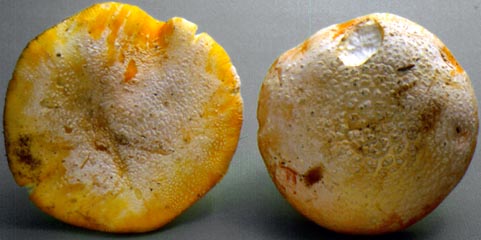
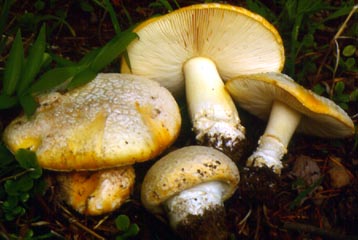
Amanita aprica J. Lindgr. & Tulloss
Loc.: BC CA OR WA
Lit.: [Tulloss & Lindgren 2005]
Spores: [1331/66/27] (8.0-) 9.5 - 13.0 (-21) × (5.0-) 6.5 - 8.5 (-12.5) µm, (L =
(9.8-) 10.1 - 12.2 (-13.1) µm; L' = 11.1 µm; W = (6.6-) 6.8 - 8.1 (-8.4) µm; W' = 7.4 µm; Q = (1.22-) 1.35 - 1.71 (-2.13); Q = (1.38-) 1.42 - 1.62 (-1.80); Q' = 1.52).
[image]
Amanita aurantisquamosa Trueblood, O. K. Mill. & Dav. T. Jenkins
Loc.: ID
Lit.: [Mille., Trueb., & Jenki. 1990]
Spores: From protolog 10.2 - 12.5 × 9.4 - 10.9 μm, (Q = 1.04 - 1.25; Q' = 1.15)
Pileus 35-70 mm wide, light tan to pale tannish-orange; white to pale orange scales near the middle and base of the stem.
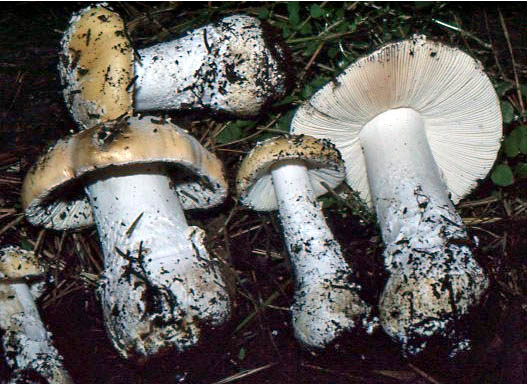
Amanita breckonii Thiers & Ammirati
Loc.: CA
Lit.: [Breckon thesis], [Thiers & Ammirati 1982]
Spores: [320/16/3] (7.2-) 10.0 - 12.8 (-16.0) × (4.5-) 6.2 - 7.8 (-9.0) µm, (L = 10.9 - 12.0 (-12.2) µm; L’ = 11.3 µm; W = (6.6-) 6.7 - 7.1 (-7.2) µm; W’ = 6.9 µm; Q = (1.31-) 1.47 - 1.89 (-2.29); Q = (1.55-) 1.58 - 1.74 (-1.85); Q’ = 1.65).
[image]
Amanita chrysoblema G. F. Atk. in Kauffman
Loc.: ID
Lit.: [Jenkins 1982]
Spores: [40/2/2] (8.4-) 9.1 - 11.0 (-11.5) × 6.6 - 8.5 (-8.7) μm, (L = 9.3 - 10.5 μm; L' = 9.9; W = 7.2 - 7.8 μm; W' = 7.5 μm; Q = (1.18-) 1.24 - 1.43 (-1.53); Q = 1.31 - 1.35; Q' = 1.33).
White form of the most common N. American muscariod species.
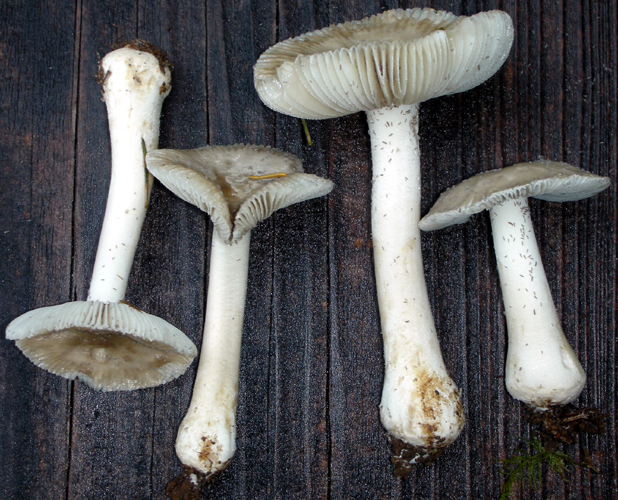
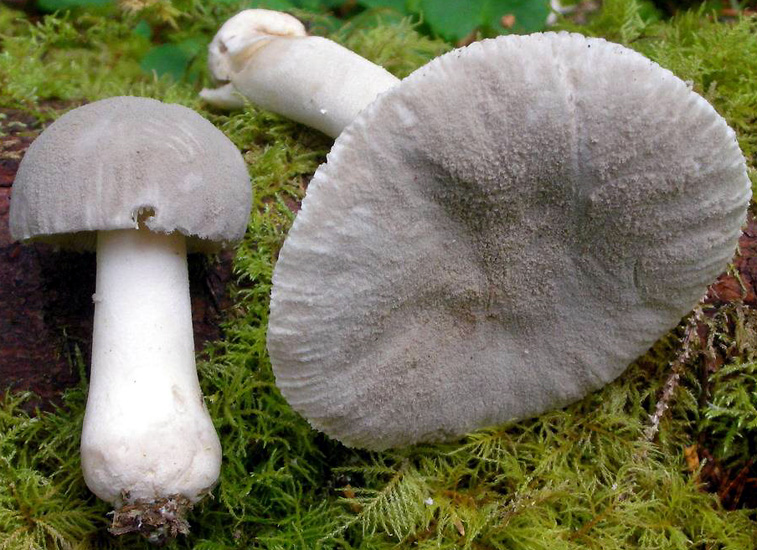
Amanita farinosa sensu Thiers
Loc.: CA OR WA
Lit.: [Thiers 1982]
Spores: [140/6/5] (6.5-) 7.5 – 9.5 (-10.6) × (5.0–) 5.5 – 7.2 (–7.6) µm,
(L = 8.1 - 9.1 µm; L’ = 8.5 µm; W = 6.1 - 6.6
µm; W’ = 6.4 µm; Q = (1.14–) 1.20 – 1.49 (–1.70); Q =
1.28 - 1.40; Q’ = 1.33).
This species is distinct from the true farinosa Schwein. of eastern
North America and the farinosa sensu Zhu L. Yang of eastern Asia.
[image]
Amanita gemmata01
Loc.: BC OR WA
Spores: [120/6/6] (8.8-) 9.0 - 11.2 (-12.8) × (6.0-) 6.8 - 8.5
(-9.8) μm, (L = 9.9 - 10.6 μm; L’ = 10.2 μm; W =
7.4 - 7.9 μm; W’ = 7.7 μm; Q = (1.12-) 1.22 - 1.47 (-1.53);
Q = 1.25 - 1.38; Q’ = 1.32).
Pileus 20-65 mm wide, creamy yellow to tannish yellow or slightly
orangish tan or orangish yellow over disc, yellow to pale creamy yellow
to cream at margin; universal veil as a narrowly limbate volva, sometimes
with a second larger flaring limb. The number of gemmatoid
taxa in the region is not known.
Amanita gemmata02
Loc.: CA
Lit.: [Thiers 1982]
Spores: “9-13 × 6.5-9 μm, subglobose to subellipsoid, inamyloid”; Q = approx. 1.4.
Pileus 56-58 mm wide, pale yellow orange to tannish cream with tan disc; universal veil as a short, somewhat appressed limb or ridge encircling top of bulb.
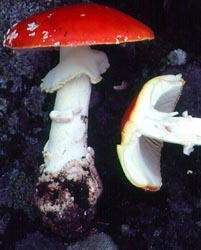
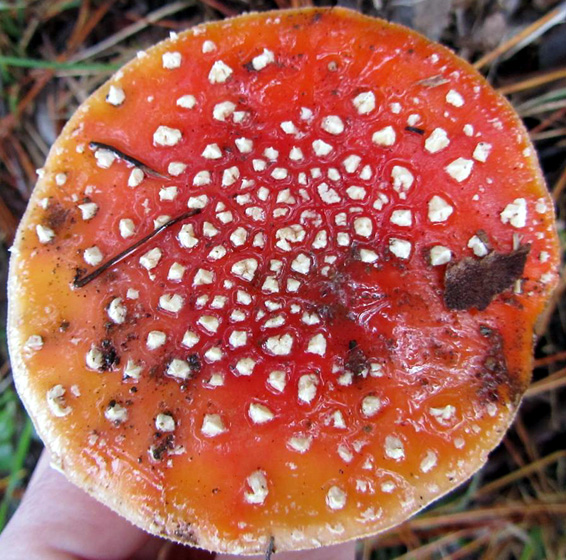
Amanita muscaria (L. : Fr.) Lam.
Loc.: AK CA (white)
Lit.: [Geml, Tull., Laur., Sazan. & Tayl. 2008]
Spores: [615/31/26] (7.4-) 8.5 - 11.5 (-13.1) × (5.6-) 6.5 - 8.5 (-9.8) µm, (L = (8.7-) 9.1 - 11.2 (-11.4) µm; L’ = 10.0 µm; W = (6.5-) 6.8 - 8.1 (-8.2) µm; W’ = 7.5 µm; Q = (1.10-) 1.22 - 1.46 (-1.75); Q = 1.26 - 1.41 (-1.42); Q’ = 1.34).
[image]
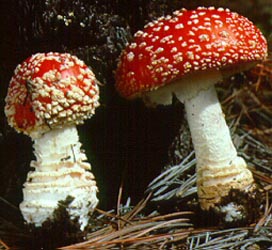
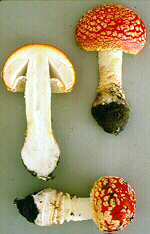
Amanita muscaria subsp. flavivolvata Singer
Loc.: CA OR WA
Lit.: [Geml, Tull., Laur., Sazan. & Tayl. 2008]
Spores: [957/48/37] (7.5-) 9.0 - 12.8 (-19.0) × (5.5-) 6.5 - 8.5 (-11.5) µm, (L = (8.9-) 9.4 - 12.1 (-14.6) µm; L’ = 10.8 µm; W = (6.6-) 6.9 - 8.2 (-8.4) µm; W’ = 7.6 µm; Q = (1.11-) 1.26 - 1.67 (-2.23); Q = (1.29-) 1.31 - 1.65 (-1.95); Q’ = 1.42)
[image]
Amanita pantherinoides (Murrill) Murrill
Loc.: OR WA
Lit.: [Jenkins 1977], [Jenkins 1979]
Spores: [75/3/3] (8.1-) 8.5 - 11.2 (-12.2) × (6.0-) 6.3 - 7.7 (-8.5) μm,
(L = 9.7 - 10.2 μm; L' = 10.0 μm; W = 6.7 - 7.2 μm;
W' = 6.9 μm; Q = (1.16-) 1.30 - 1.58 (-1.69); Q = 1.42 -
1.46; Q' = 1.44).
Pileus 30-100 mm wide, honey colored to dirty-cream with white patches
and warts; limbate volval remnants on stem base.
Amanita pseudo-albopantherina G. Wright nom. prov.
Loc.: CA
Lit.: [G. Wright ms.]
Spores: “9.5 - 12.1 × 5.9 - 6.2 μm, (Q = 1.79), inamyloid, ellipsoid to ovoid.”
Pileus 60 mm wide, white; stipe with superior, skirt-like partial veil; universal veil as a thick rim around lower porion of stipe, with a longer flat free limb.
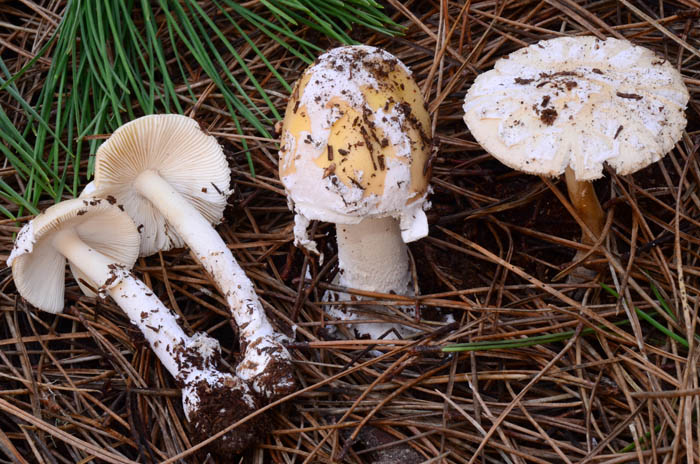
Amanita pseudobreckonii Siegel & Schwarz nom. prov.
Loc.: CA
Siegel and Schwarz state: "The [cap] color is a distinctive but difficult to describe mix of pale straw yellow with pinkish tan or peachy tones."
[image]
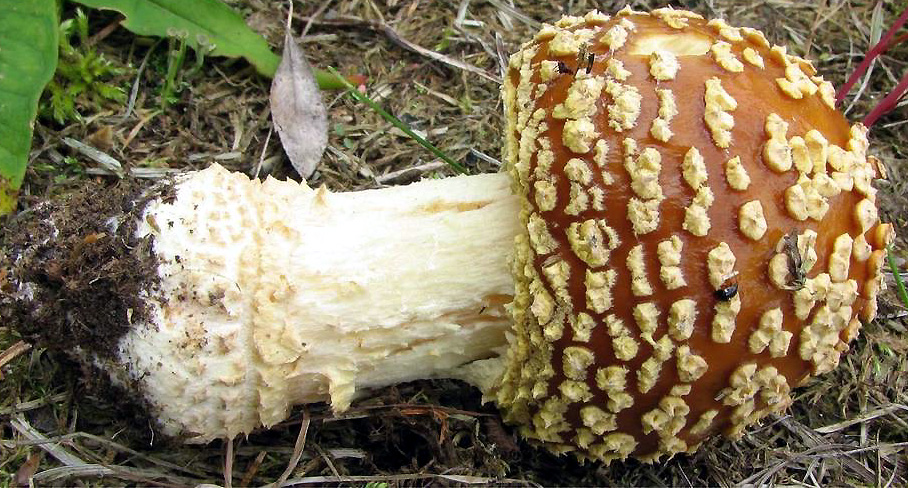
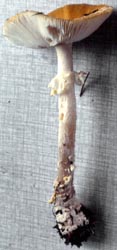
Amanita regalis (Fr.) Michael
Loc.: AK
Lit.: [Geml, Tull., Laur., Sazan. & Tayl. 2008]
Spores: [360/18/13] (8.0-) 9.0- 11.6 (-17.0) × (5.9-) 6.5 - 8.8 (-12.0) µm, (L = (9.4-) 9.8 - 11.6 µm; L’ = 10.3 µm; W = 6.9 - 8.5 (-8.6) µm; W’ = 7.7 µm; Q = (1.10-) 1.22 - 1.50 (-1.73); Q = 1.26 - 1.40 (-1.43); Q’ = 1.34).
[image]
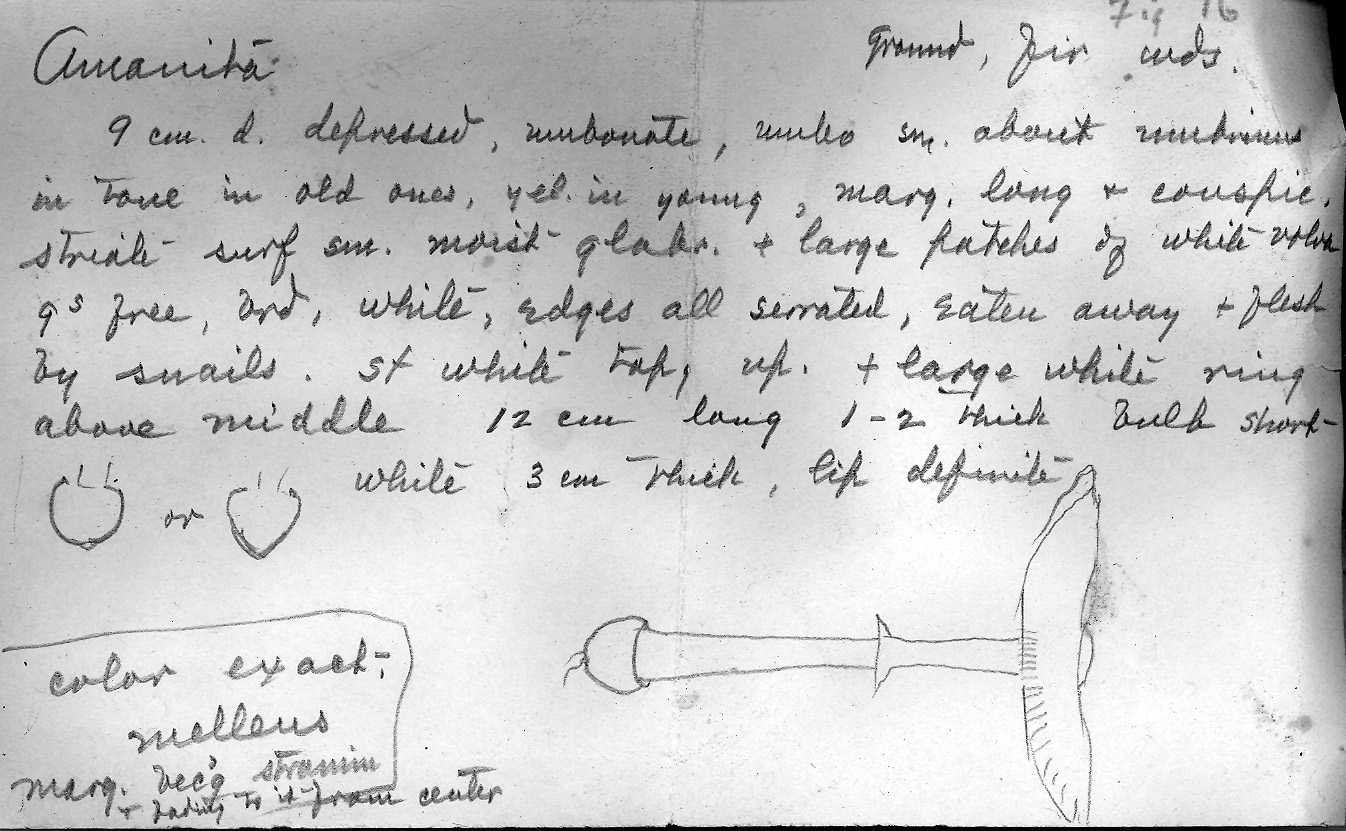
Amanita umbrinidisca (Murrill) Murrill
Loc.: WA
Lit.: [Jenkins 1979]
Spores: from type study of Jenkins
(1977,
1979) 10.2 - 11.7 × 7.0 -
7.8 (-8.6) μm, (Q = 1.31 - 1.56; Q' = 1.46).
[image]
Amanita sp. Breckon 676
Loc.: CA
Lit.: [Breckon thesis]
Spores: “(8.0-) 11.2 - 12.8 (-14.4) × (4.8-) 5.6 - 7.2 (-8.0)” μm
Pileus 140-150 mm wide, cream at margin, Pinkish Buff over disc,
Massicot Yellow to Maize Yellow under pileipellis; universal veil as a
white, thin, membranous sheath collapsing on stipe.
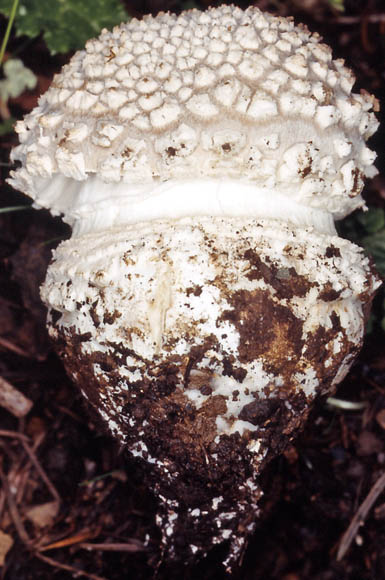
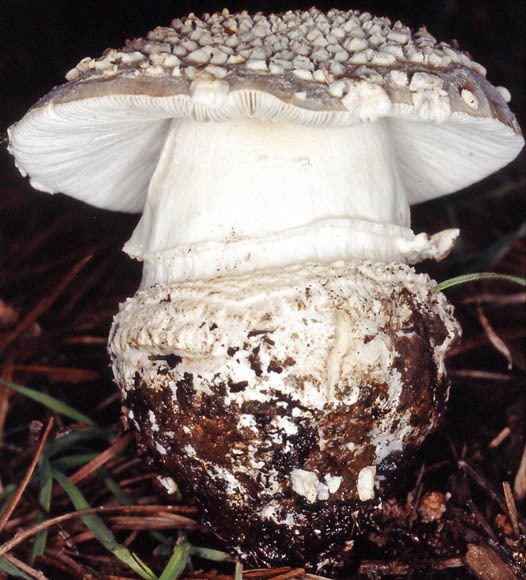
Amanita sp-C17
Loc.: CA
Spores: [20/1/1] (8.5-) 9.0 - 10.5 (-11.2) × (6.0-) 6.5 - 7.5 (-7.9) μm,
(L = 9.8 μm; W = 6.9 μm; Q = (1.24-) 1.29 - 1.50 (-1.54);
Q 1.41).
[image]
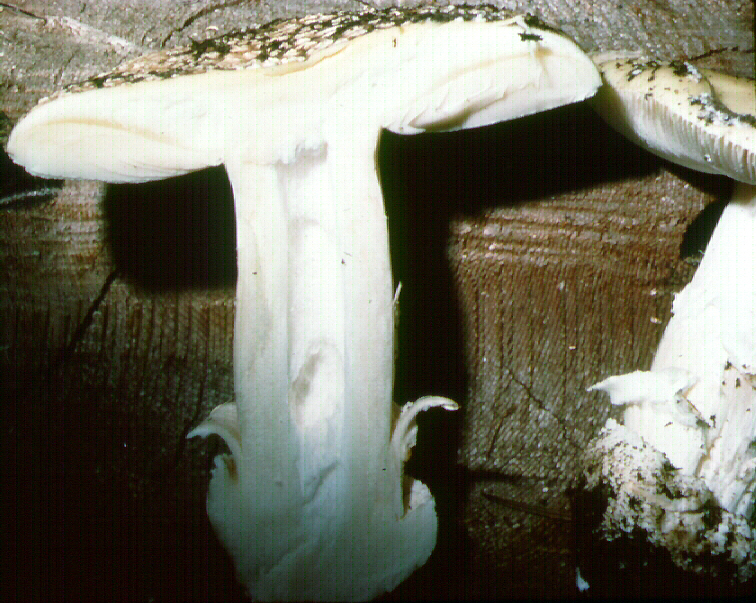
Amanita sp-C19
Loc.: WA
Spores: [41/2/1] (8.5-) 9.2 - 12.2 (-16.0) × (5.8-) 6.2 - 8.0 (-10.8) μm, (L = 10.7 μm; L'= 10.7 μm; W =7.1 μm; W' = 7.1 μm; Q = (1.32-) 1.35 - 1.66 (-2.0); Q = 1.51 - 1.52; Q' = 1.51).
[image]
Amanita sp-C21
Loc.: CA
Spores: [20/1/1] (9.5-) 10.0 - 13.0 (-17.2) × 7.4 - 8.5 (-9.8) μm,
(L = 11.5 μm; W = 7.9 μm; Q = (1.25-) 1.28 - 1.60 (-1.95);
Q = 1.46).
Pileus 75-94 mm wide, coppery orange with margin browner than disc;
universal veil as smooth buffy gray patches unevenly distributed over
cap and over the stipe below the partial veil.
Amanita sp-LG1045
Loc.: CA
Spores: [59/2/2] (10.0-) 10.1 - 13.3 (-15.3) × (6.3-) 6.8 - 8.9 (-10.4) μm, (L = 10.8 - 12.2 μm; L’ = 11.5 μm; W = 7.2 - 8.1 μm; W’ = 7.7 μm; Q = (1.29-) 1.39 - 1.59 (-1.65); Q = 1.49 - 1.50; Q’ = 1.50).
Pileus 40 mm wide, yellow to orange to pink, margin non striate;
universal veil as a white central patch.
Amanita sp-LG458
Loc.: CA
Spores: [30/1/1] (10.0-) 10.3 - 15.0 (-16.0) × (6.3-) 6.5 - 8.4 (-9.0) μm, (L = 11.8 μm; L’ = 11.8 μm; W = 7.3 μm; W’ = 7.3 μm; Q = (1.47-) 1.50 - 1.88 (-2.04); Q = 1.63; Q’ = 1.63).
The species is known only from Santa Cruz Island, CA.
Amanita sp-NW01
Loc.: OR WA
Spores: [20/1/1] (8.5-) 8.8 - 10.5 (-12.0) × (6.2-) 6.5 - 8.2 (-9.0) μm,
(L = 9.6 μm; W = 7.2 μm; Q = (1.17-) 1.24 - 1.42 (-1.46); Q = 1.34).
Pileus 65-71 mm wide, brown to almost white; universal veil like that of
A. pantherina.
Amanita sp-NW07
Loc.: WA
Spores: [20/1/1] (9.7-) 10.0 - 11.0 (-12.0) × (6.9-) 7.0 - 8.0 (-9.0) μm, (L = 10.6 μm; W = 7.7 μm; Q = (1.25-) 1.29 - 1.47 (-1.50); Q = 1.38).
Pileus pale tan to yellow with “butterscotch” disc; universal veil as
pronounced limbate volva.
Section Caesareae
(Stipe lacking a bulb at its base; having an annulus.)
[ sectional links ]
[ top ]
[ meaning of biometric variables ]
[ bibliography ]
[ Amanita Studies home ]
[ checklists & keys page ]
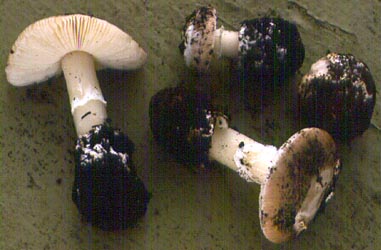
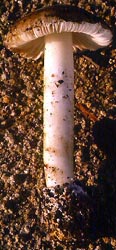
Amanita calyptratoides Peck.
Loc.: BCN CA WA
Spores: [240/11/10] (8.5-) 9.8 - 14.0 (-17.0) × (5.5-) 6.5 - 8.9 (-11.8) μm, (L = (11.2-) 11.6 0 13.0 μm; L' = 12.0 μm; W = (7.3-) 7.6 - 8.0 μm; W' = 7.8 μm; Q = (1.26-) 1.36 - 1.82 (-1.99); Q = (1.40-) 1.44 - 1.70; Q' = 1.55).
[ image]
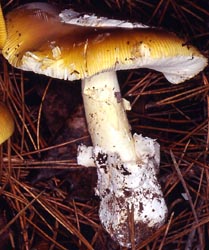
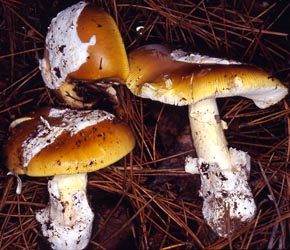
Amanita calyptroderma G. F. Atk. & V. G. Ballen.
Loc.: CA OR WA
Spores: [160/8/6] (8.6-) 9.0 - 12.0 (-24) × (5.5-) 5.8 - 7.0 (-8.5) μm, (L = 9.9 - 10.9 (-11.1) μm; L' = 10.4 μm; W = (6.1-) 6.3 - 6.6 μm; W' = 6.4 μm;
Q = (1.29-) 1.43 - 1.81 (-3.0); Q = 1.55 - 1.68 (-1.69); Q' = 1.62)
[image]
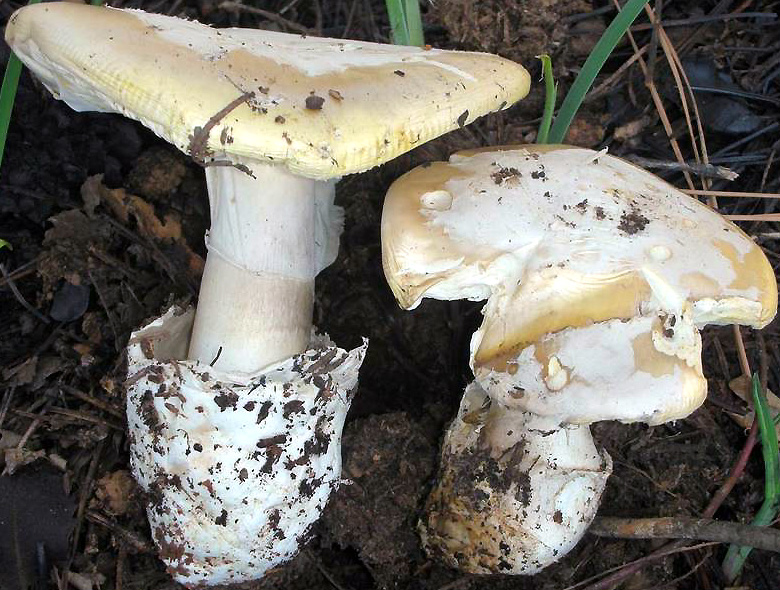
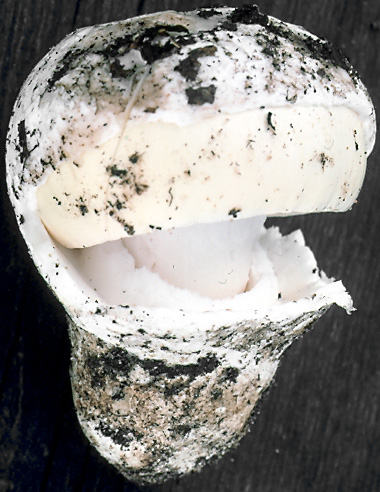
Amanita vernicoccora Bojantchev & R.M. Davis
Loc.: CA OR WA
Lit.: [Bojan., Penny., & Davis 2011]
Spores: [138/7/6] (9.0-) 9.5 - 12.4 (-17.2) × (5.5-) 6.0 - 7.8 (-9.8) µm, (L = 10.6 - 11.2 µm; L’ = 10.9 µm; W = 6.6 - 7.3 µm; W’ = 6.9 µm; Q = (1.35-) 1.40 - 1.77 (-2.18); Q = 1.53 - 1.67 ; Q’ = 1.57)
[image]
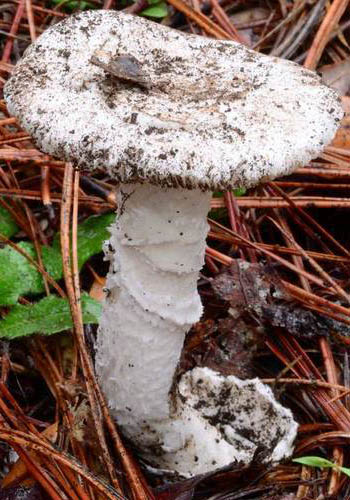
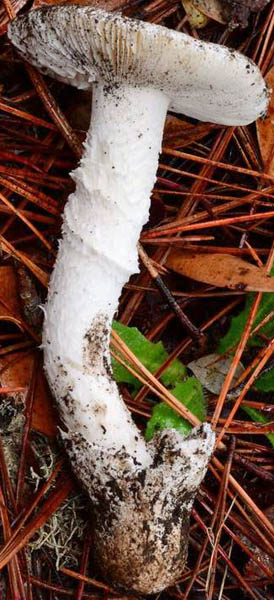
Amanita sp-C22
Loc.: CA
This species is similar to A. calyptratoides in size and shape; however, A. sp-C22 differs in being entirely white and having a submembranous ring on the stem.
[image]
Section Vaginatae (Stipe lacking a bulb at its base and lacking an annulus.)
[ sectional links ]
[ top ]
[ meaning of biometric variables ]
[ bibliography ]
[ Amanita Studies home ]
[ checklists & keys page ]
Amanita atrobrunnea G. Wright nom. prov.
Loc.: CA
Lit.: [G. Wright ms.]
Spores: “11.2 - 13.5 × 8.7 - 10.6 μm; Q = 1.28.”
Pileus 50-75 mm wide, dark brown; thickness of universal veil not specified.


Amanita calisorora
Loc.: CA
Spores: [13/1/1] (9.5-) 10.2 - 12.2 (-13.0) × (8.5-) 9.3 - 10.7 (-12.0) μm, (L = 11.3 μm; W = 10.1 μm; Q = (1.08-) 1.09 - 1.16 (-1.21); Q = 1.12).
[image]
Amanita calyptrovelosa G. Wright nom. prov.
Loc.: CA
Lit.: [G. Wright ms.]
Spores: “8.8 - 13.3 × (8-) 8.4 - 9.2 (-10.2) μm,” with “Q = 1.41”
Pileus 70-105 mm wide, white; universal veil as a single large white patch.
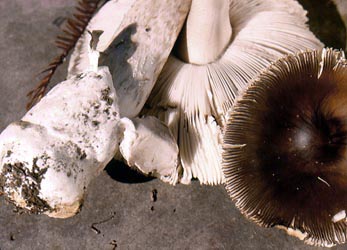
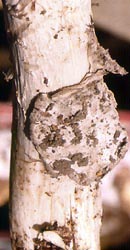
Amanita constricta Thiers & Ammirati
Loc.: CA OR
Lit.: [Thiers & Ammirati 1982], [Tulloss 1994]
Spores: [454/23/9] (7.2-) 9.5 - 12.8 (-19.0) × (6.2-) 8.2 - 11.5 (-17.8) μm, (L = (10.3-) 10.4 - 11.8 μm; L' = 11.0 μm; W = (8.8-) 9.0 - 10.5 (-10.9) μm; W' = 9.9 μm; Q = (1.0-) 1.04 - 1.25 (-1.56); Q = (1.06-) 1.07 - 1.17 (-1.18); Q' = 1.12).
[image]
Amanita crassiputamen Tulloss nom. prov.
Loc.: CA
Lit.: [Tulloss 1994]
Spores: [120/6/2] (7.8-) 9.5 - 12.2 (-16.2) × (7.5-) 8.5 - 11.0 (-13.8) µm, (L = 10.2 - 11.6 µm; L’ = 10.7 µm; W = 9.1 - 10.6 µm; W’ = 9.7 µm; Q = (1.02-) 1.04 - 1.19 (-1.49); Q = 1.09 - 1.13; Q’ = 1.10).
In Tulloss 1994 this was called species NW5
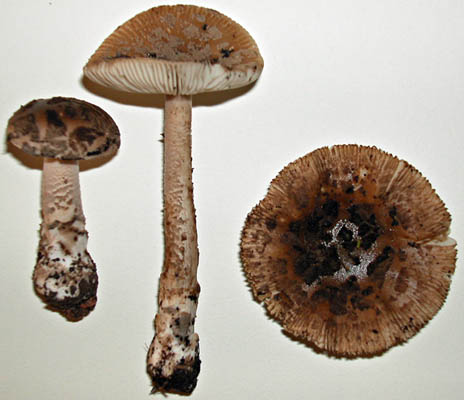
Amanita friabilis
Loc.: AK BC
Spores: [60/2/1] (8.8-) 10.0 - 12.5 (-14.0) × (6.8-) 7.2 - 9.2 (-9.5) µm, (L = 11.2 - 11.3 µm; L’ = 11.2 µm; W = 7.9 - 8.7 µm; W’ = 8.3 µm; Q = (1.13-) 1.20 - 1.60 (-1.71); Q = 1.28 - 1.43; Q’ = 1.36).
[image]
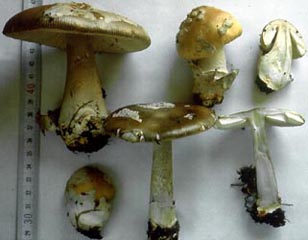
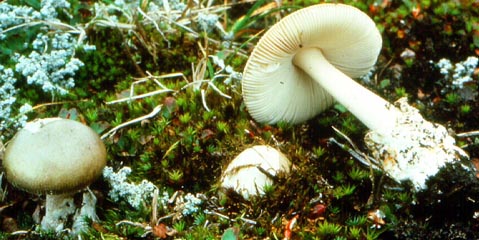
Amanita groenlandica Bas ex Knudsen & Borgen
Loc.: AK
Lit.: [Tulloss 1994]
Spores: [240/10/8] (7.8-) 9.2 - 12.5 (-23) × (7.8-) 8.2 - 11.5 (-16.0) μm, (L = 9.7 - 11.4 (-12.2) μm; L' = 10.9 μm; W = (8.9-) 9.3 - 10.6 μm; W' = 9.0 μm; Q = (1.0-) 1.02 - 1.20 (-1.44); Q = 1.08 - 1.12 (-1.15); Q' = 1.11).
[image]

Amanita pachycolea Stuntz In Thiers & Ammirati
Loc.: CA
Lit.: [Thiers & Ammirati 1982], [Tulloss 1994]
Spores: [420/20/14] (7.8-) 10.0 - 13.5 (-16.5) × (7.5-) 8.8 - 11.8 (-14.0) µm, (L = (10.7-) 10.8 - 12.1 (-12.2) µm; L’ = 11.5 µm; W = 9.6 - 11.1 (-11.2) µm; W’ = 10.4 µm; Q = (1.0-) 1.04 - 1.28 (-1.65); Q = 1.06 - 1.20 (-1.21); Q’ = 1.11).
[image]
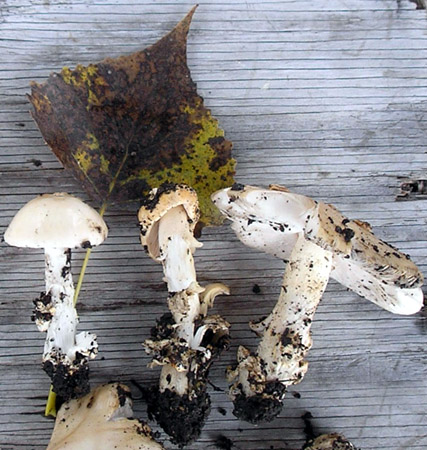

Amanita populiphila Tulloss & E. Moses
Loc.: ID
Lit.: [Tulloss & Moses 1995]
Spores: [1200/61/24] (7.0-) 9.2 - 12.5 (-21) × (6.0-) 8.5 - 11.5 (-15.8) µm, (L = (10.0-) 10.1 - 11.9 (-12.3) µm; L’ = 10.9 µm; W = (8.9-) 9.1 - 10.7 (-11.1) µm; W’ = 9.9 µm; Q = (1.0-) 1.04 - 1.20 (-1.61); Q = (1.06-) 1.08 - 1.15 (-1.19); Q’ = 1.11).
[image]


Amanita protecta Tulloss & G. Wright
Loc.: CA
Lit.: [Tulloss & Wright 1989]
Spores: [448/22/13] (8.7-) 9.5 - 13.0 (-20.5) × (7.3-) 8.7 - 11.5 (-16.2) µm, (L = 10.3 - 12.3 (-12.4) µm; L’ = 11.2 µm; W = (9.0-) 9.1 - 10.8 (-11.2) µm; W’ = 9.9 µm; Q = (1.0-) 1.03 - 1.27 (-1.43); Q = (1.07-) 1.10 - 1.19; Q’ = 1.14)
[image]
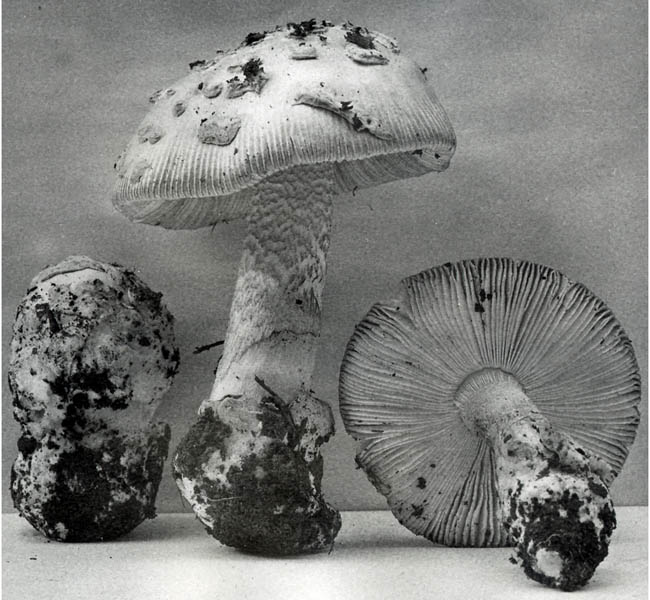
Amanita stannea A. H. Sm. ex Tulloss
Loc.: ID
Lit.: [A. H. Sm. ms.]
Spores: 10 - 15 × 9 - 12 μm, (est. Q = 1.10 - 1.25)
[image]

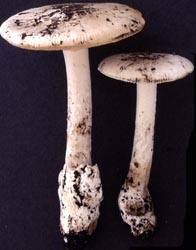
Amanita velosa (Peck) Lloyd
Loc.: BCN CA OR
Lit.: [Arora 1986]
Spores: [70/3/3] (8.7-) 9.1 - 12.0 (-16.3) × (7.0-) 7.7 - 10.0 (-13.0) µm, (L = 9.7 - 11.0 µm; L’ = 10.4 µm; W = 8.5 - 9.1 µm; W’ = 8.8 µm; Q = (1.04-) 1.08 - 1.30 (-1.49); Q = 1.15 - 1.24; Q’ = 1.19).
[image]
Amanita vaginata sensu Thiers
Loc.: CA
Lit.: [Thiers 1982]
Spores: “7.0 - 12.0 × 6.0 - 9.0 μm,” Q approx. 1.25
Pileus gray or grayish brown; universal veil not fragile.
Amanita sp. A. H. Sm. 60677
Loc.: OR
Lit.: [A. H. Sm. ms.]
Spores: “11 - 14 × 9 - 12 μm,” with Q approx. 1.2
Pileus and stipe becoming tinged rather quickly with Cinnamon Buff; stipe white, becoming flushed with
Cinnamon Buff; universal veil thick, but fragile.
Amanita sp. A. H. Sm. 65576
Loc.: ID
Lit.: [A. H. Sm. ms.]
Spores: “9 - 12 (-13),” with Q approx. 1
Pileus a shade of brown or gray, universal veil markedly grayish early on, often breaking up and disappearing.
Amanita sp. A. H. Sm. 65577
Loc.: ID
Lit.: [A. H. Sm. ms.]
Spores: “globose 9 - 12 μm,” with Q approx. 1.0
Pileus a shade of gray or brownish gray; universal veil very fragile.
Amanita sp-AZ15
Loc: BCN
Spores: [81/2/2] (10.0-) 10.8 - 13.8 (-17.5) × (5.8-) 6.5 - 9.0 (-13.0±) µm, (L = 11.7 - 12.6 µm; L’ = 12.1 µm; W = 7.3 - 7.9 µm; W’ = 7.6 µm; Q = (1.23-) 1.43 - 1.84 (-2.28); Q = 1.60; Q’ = 1.60).
Pileus 30-38 mm wide, pale yelowish; universal veil absent or as a large white patch over the disc.
Amanita sp. Collier 1
Loc.: OR
Lit.: [A. H. Sm. ms.]
Spores: "9 - 11 μm,” with Q approx. 1
Pileus with cream disc; universal veil having some remnants pulled up 50± mm by elongation of stipe.
Amanita sp. Cripps 331
Loc.: ID
Lit.: [C. Cripps Pers. Comn.]
Spores: [40/1/1] (10.5-) 11.0 - 13.0 (-13.8) × (8.2-) 8.5 - 11.0 (-11.5) μm, with Q = 1.23
Pileus 60 mm wide, white with a striate margin; found with Populus tremuloides.
Amanita sp. Folsom 3.xi.1973
Loc.: OR
Lit.: [A. H. Sm. ms.]
Spores: “globose 10 - 14 μm,” with Q approx. 1
Pileus graying with age; universal veil graying with age, submembranous, often with strangulate region.

Amanita sp-McAdoo-358-1
Loc.: WA
Lit.: [McAdoo Pers. Comn.]
Spores: [20/1/1] (8.1-) 9.0 - 12.5 (-17.4) × 7.5 - 11.3 (-17.0) μm, (L = 11.0 μm; L' = ?? μm; W = 10.0 μm; W' = ?? μm; Q = 1.04 - 1.22 (-1.23); Q = 1.10; Q' = ??).
[image]
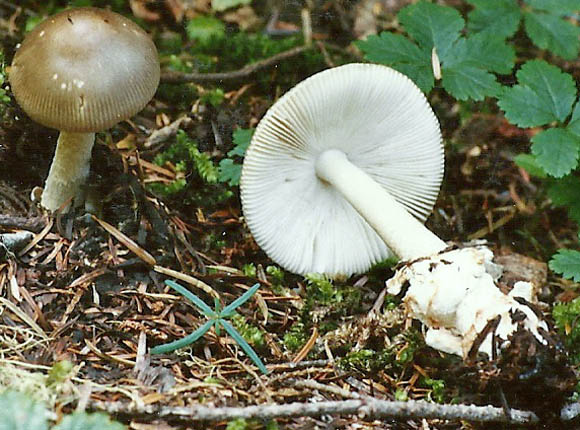
Amanita sp-NW04
Loc.: BC CA OR WA
Spores: [280/14/9] (7.0-) 10.0 - 13.2 (-19.2) × (6.0-) 9.0 - 12.2 (-17.8) µm, (L = 10.8 - 12.3 (-12.8) µm; L’ = 11.6 µm; W = 9.9 - 11.2 (-12.0) µm; W’ = 10.7 µm; Q = (1.0-) 1.03 - 1.17 (-1.25); Q = 1.07 - 1.11 (-1.12); Q’ = 1.09).
[image]
Amanita sp-NW05
Loc.: CA WA
Spores: [60/2/2] (8.8-) 9.8 - 12.8 (-18.5) × (7.8-) 8.0 - 11.0 (-13.0) µm, (L = 10.9 - 11.7 µm; L’ = 11.2 µm; W = 9.5 - 10.2 µm; W’ = 9.8 µm; Q = (1.02-) 1.07 - 1.27 (-1.42); Q = 1.15; Q’ = 1.15).
Pileus 50 mm wide, gray-brown; universal veil as large white calyptra that develops orange rusty stains.
Amanita sp-NW09
Loc.: OR
Spores: [60/3/2] (7.9-) 10.2 - 13.5 (-16.5) × (6.3-) 6.6 - 9.0 (-10.0) µm, (L = 11.4 - 12.3 µm; L’ = 11.8 µm; W = 7.6 - 7.8 µm; W’ = 7.7 µm; Q = (1.25-) 1.37 - 1.76 (-1.85); Q = 1.49 - 1.58; Q’ = 1.54).
Pileus 33-79 mm wide, white with pinkish or grayish tint over disc; universal veil absent or as thin white to tan patches.


Amanita sp-OR01
Loc.: OR
Spores: [36/1/1] (9.2-) 10.5 - 12.0 (-14.2) ×: (7.5-) 8.3 - 10.0 (-10.6) μm, (L = 11.3 μm; W = 9.1 μm; Q = (1.06-) 1.14 - 1.33 (-1.60); Q = 1.24).
[image]
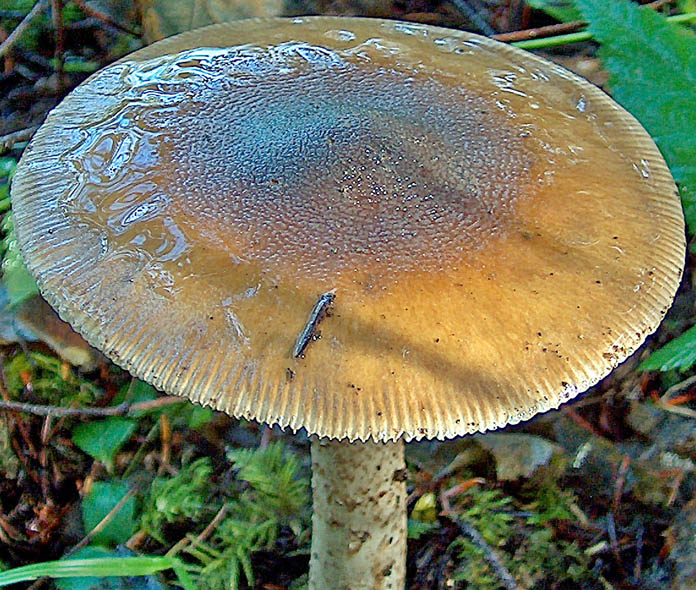
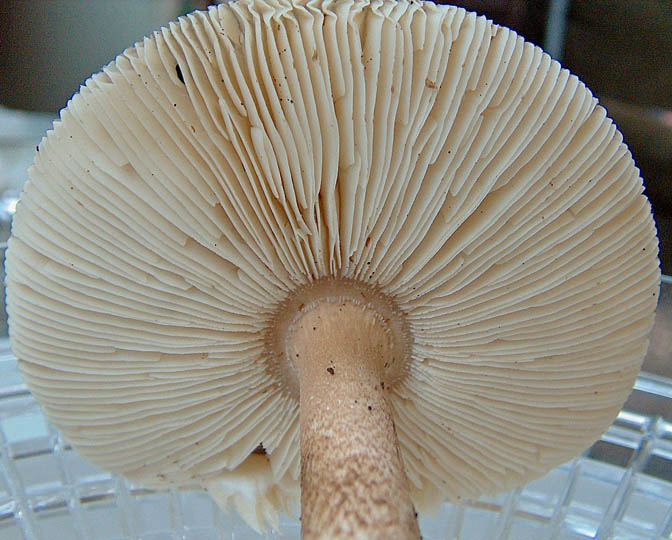
Amanita sp-OR02
Loc.: OR
The collector called attention to the finely rugose surface of the disc region of the pileus.
[image]
Amanita sp-WA02
Loc.: BC CA OR WA
Spores: [40/2/2] (10.1-) 11.2 - 12.2 (-14.0) × (9.1-) 10.1 - 11.9 (-13.3) μm
Pileus brown, striate margin; gray weakining volva, compare with A. constricta, A. crassiputamen, and A. sp-NW04.
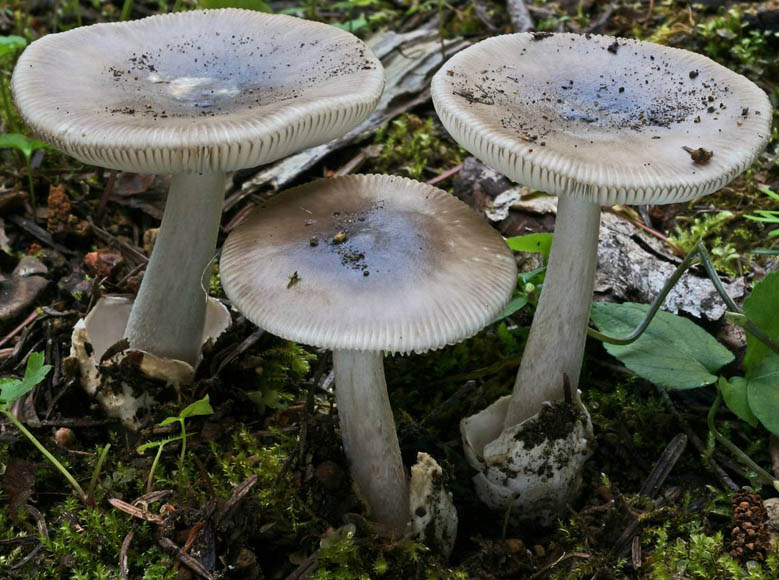
Amanita sp-WA03
Loc.: WA
Spores: [40/2/1] (10.2-) 10.6 - 15.1 (-16.9) × (8.5-) 8.7 - 11.2 (-12.0) μm, (L = 12.2 - 12.5 μm; W = 9.8 - 10.0 μm; Q = (1.09-) 1.13 - 1.42 (-1.54); Q = 1.24 - 1.25).
[image]
Subgenus Amanitina (Spores amyloid. Taxa mycorrhizal)
Section Amidella (Margin appendiculate—at least at first. Volva as a multilayered, thick-limbed, sac on a bulbless stipe base. Many taxa in this section have the unusual combination of amyloid spores with a striate cap margin and truncate lamellae. Species in this section often require microscopic examination for certain identification. A frequent exception is A. whetstoneae. [RET has personal correct field ID rate of around 75%—inadequate.] Many species in this section will stain pinkish (sometimes very briefly) if collected in moist weather or otherwise in very fresh condition. Toxicity of North American taxa of sect. Amidella is unknown.)
[ sectional links ]
[ top ]
[ meaning of biometric variables ]
[ bibliography ]
[ Amanita Studies home ]
[ checklists & keys page ]
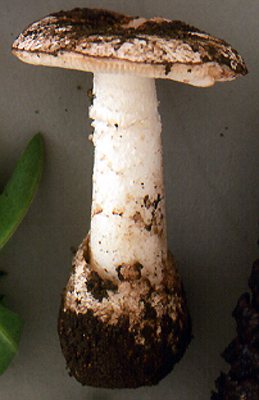
Amanita fallax Tulloss & G. Wright nom. prov.
Loc.: BCN CA
Spores: [253/13/3] (7.7-) 9.8 - 14.0 (-20.8) × (4.9-) 5.6 - 7.0 (-9.0) μm, (L = 10.7 - 12.8 (-13.2) μm; L' = 11.6 μm; W = 6.0 - 6.7 (-6.9) μm; W' = 6.3 μm; Q = (1.40-) 1.50 - 2.27 (-2.75); Q = 1.67-2.07 (-2.12); Q' = 1.85).
[image]
Section Phalloideae (All regional taxa
in this section should be assumed to contain deadly amatoxins (also called amanitins), although the concentration can vary greatly from one specimen to another even within a single species.
Soft to firm stipe bulb with limbate volva,
not complexly layered; pileus margin not appendiculate. Stipe always with a membranous
(rarely felted in A. magnivelaris)
partial veil. Basidia usually rather short and always lacking basal clamps.
[ sectional links ]
[ top ]
[ meaning of biometric variables ]
[ bibliography ]
[ Amanita Studies home ]
[ checklists & keys page ]
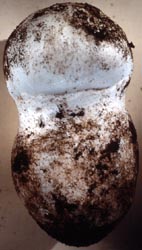
Amanita ocreata Peck
Loc.: CA WA
Lit.: [Jenkins 1978]
Spores: [260/13/10] (6.8-) 8.8 - 12.0 (-13.5) × (5.5-) 6.2 - 8.5 (-10.8) µm, (L = 9.4 - 11.1 (-11.2) µm; L’ = 10.3 µm; W = (6.6-) 6.9 - 7.9 µm; W’ = 7.4 µm; Q = (1.05-) 1.18 - 1.67 (-1.92); Q = 1.27 - 1.52 (-1.55); Q’ = 1.39).
[image]


Amanita phalloides (Fr. : Fr.) Link
Loc.: BC CA
Lit.: [Arora 1986]
Spores: [316/16/15] (6.8-) 7.5 - 10.1 (-13.5) × (5.5-) 6.0 - 8.0 (-10.5) µm, (L = (7.7-) 8.3 - 9.5 µm; L’ = 8.8 µm; W = 6.4 - 7.3 (-7.4) µm; W’ = 7.0 µm; Q = (1.03-) 1.12 - 1.45 (-1.70); Q = 1.19 - 1.33 (-1.40); Q’ = 1.26).
[image]
Section Roanokenses (Cap margin appendiculate—at least when young. Stipe often, but not always, bearing a bulb. Volva rarely limbate, never as a thick-limbed, multilayered sac on a bulbless stipe base. A number of species in this section have been found to contain a non-nucleic amino acid that is a severe threat to the human kidney and liver. In the present region, Amanita smithiana falls in that group.) [Note: Also, see sp-06 under section Validae.] [ sectional links ] [ top ] [ meaning of biometric variables ] [ bibliography ] [ Amanitaceae Studies home ] [ checklists & keys page ]
Amanita californica Bas
Loc.: CA
Lit.: [Bas 1969]
Spores: [40/2/1] (6.6-) 7.1 - 9.0 (-9.2) × 5.0 - 6.2 μm, (L = 7.8 - 8.4 μm; L' = 8.1 μm; W = 5.5 - 5.8 μm; W' = 5.7 μm; Q = (1.20-) 1.32 - 1.56 (-1.60); Q = 1.42 - 1.45; Q' = 1.44).
Pileus 60-70 mm wide, whitish; universal veil white and pulverulant, almost completely covering pileus.
Amanita cokeri sensu Thiers
Loc.: CA
Lit.: [Thiers 1982]
Spores: “9.2 - 14.3 × 6.3 - 9.0 μm, subovoid to subellipsoid, amyloid,” Q = approx. 1.55
Differs from A. cokeri in having an exannulate stem. Thiers description of cap suggests that the volva directly connects to the flesh as in A. magniverrucata.
Amanita gigenteo-rubescens G. Wright nom. prov.
Loc.: CA
Lit.: [G. Wright ms.]
Spores: “10.0–11.0 × 6.4–7.1 μm; Q = 1.56.“
Pileus 120 mm wide, white with some pinkish tan in places away from the disc; universal veil as white to pale brown pyramidal warts and flat patches, partial veil becoming appressed to stipe and torn or lacking. Wright thinks this belongs in section Lepidella based on taste, odor, and spore size.
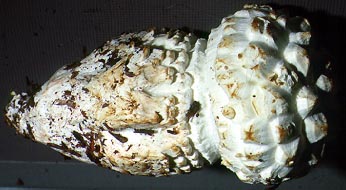
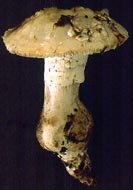
Amanita magniverrucata Thiers & Ammirati
Loc.: CA
Lit.: [Thiers & Ammirati 1982], [Tulloss 2009]
Spores: [240/11/9] (6.5–) 8.0–12.6 (–15.5) × (4.5–) 5.8–8.0 (–9.5) µm, (L = 8.5–11.6 (–12.0) µm; L’ = 10.3 µm; W = 6.0–7.4 (–7.5) µm; W’ = 6.8 µm; Q = (1.17–) 1.31–1.79 (–3.75); Q = (1.39–) 1.42–1.66; Q’ = 1.52).
[image]

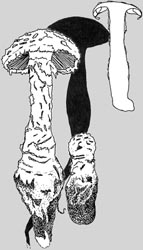
Amanita smithiana Bas
Loc.: BC CA OR WA
Lit.: [Bas 1969], [Tulloss & Lindgren 1992]
Spores: [2060/104/93] (6.5-) 8.8 - 12.0 (-16.0) × (4.3-) 5.8 - 8.0 (-10.8) µm, (L = (8.6-) 9.4 - 11.2 (-11.7) µm; L’ = 10.4 µm; W = (5.5-) 6.0 - 7.4 (-7.8) µm; W’ = 6.8 µm; Q = (1.12-) 1.33 - 1.77 (-2.36); Q = (1.29-) 1.43 - 1.68 (-1.98); Q’ = 1.54).
[image]
Amanita sp-C01
Loc.: CA
Spores: [25/1/1] (7.3-) 7.7 - 9.4 (-10.1) × 4.9 - 6.6 (-7.0) μm, (L = 8.5 μm; L’ = μm; W = 5.8 μm; W’ = μm; Q = (1.30-) 1.32 - 1.57 (-1.67); Q = 1.47)
Pileus 70-120 mm wide, whiteish; universal veil as white pulverulant detersile warts. Possibly= A. silvicola
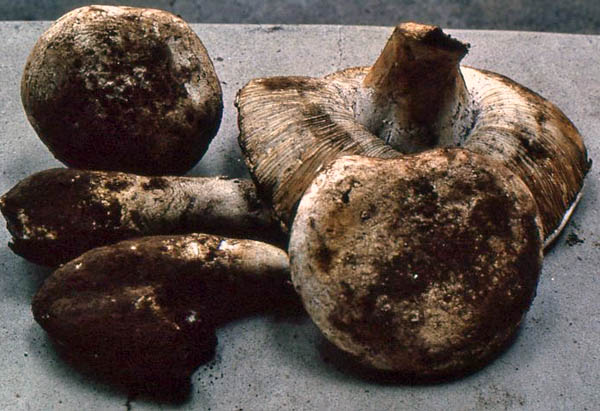
Amanita sp-C03
Loc.: CA
Spores: [60/3/1] (9.1-) 9.8 - 13.3 (-16.1) × (4.5-) 4.9 - 7.0 (-8.4) µm, (L = 11.5 - 11.9 µm; L’ = 11.6 µm; W = 5.2 - 5.8 µm; W’ = 5.6 µm; Q = (1.66-) 1.78 - 2.48 (-2.56); Q = 2.01 - 2.21; Q’ = 2.10).
[image]

Amanita sp-C05
Loc.: CA
Spores: [81/4/3] (8.0-) 9.4 - 13.3 (-14.3) × (5.6-) 6.5 - 8.0 (-8.5) µm, (L = 11.1 - 12.2 µm; L’ = 11.5 µm; W = 7.2 - 7.5 µm; W’ = 7.3 µm; Q = (1.17-) 1.42 - 1.80 (-1.96); Q = 1.48 - 1.65; Q’ = 1.57).
[image]
Amanita sp-C06
Loc.: CA
Spores: [40/1/1] (7.7-) 8.4 - 10.5 (-10.8) × 4.9 - 7.0 µm, (L = 9.2 - 9.3 µm; L = 9.3 µm; W = 6.1 µm; Q = (1.30-) 1.36 - 1.71 (-1.86); Q = 1.52).
Pileus ca. 85 mm wide, white; universal veil as plentiful medium sized pyramidal warts.
Amanita zayantensis
Loc.: CA
Lit.: [Arora 1986 as "A. baccata"]
Spores: [80/3/2] (8.8-) 9.8 - 12.5 (-15.8) × (4.8-) 5.2 - 6.5 (-8.5) μm, (L = 10.6 - 11.7 μm; L' = 11.1 μm; W = 5.6 - 6.3 μm; W' = 5.8 μm; Q = (1.54-) 1.68 - 2.16 (-2.56); Q = 1.80 - 1.98; Q' = 1.90).
Pileus 40-100 mm wide, white, margin appendiculate with subfelted material; universal veil as white powdery warts or patches or a think layer of loose fibrils.
Section Validae
(Universal veil almost always friable, appearing as a small limb only in taxa with a
marginate stipe bulb. Stipe always annulate.
Pilei may be brightly colored. Basidia usually rather short and always lacking basal
clamps. While some of the
taxa in this section may not contain a hemolytic compound, a number of them do. Therefore, ingestion of species in this section without
thorough cooking is to be strongly discouraged. Experimentation with eating
amanitas is not a good idea at any rate.)
[ sectional links ]
[ top ]
[ meaning of biometric variables ]
[ bibliography ]
[ Amanita Studies home ]
[checklists & keys page ]


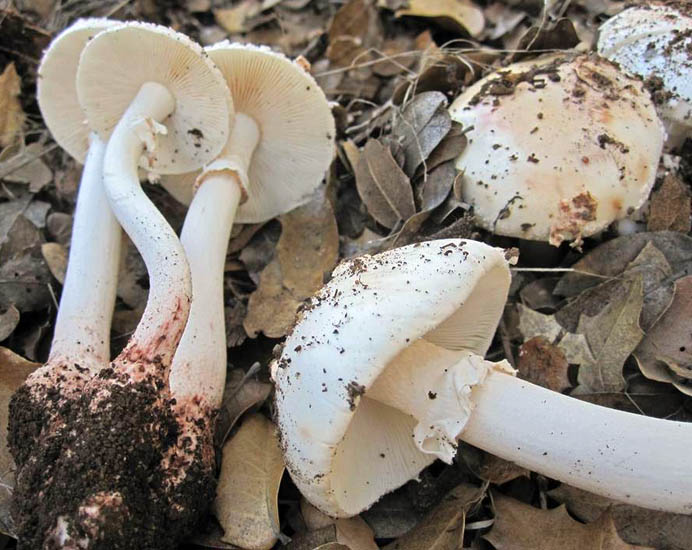
Amanita cruetilemurum Tulloss, Rodr. Cayc. & K. W. Hughes nom. prov.
Loc.: CA
Spores: [80/4/1] (9.5-) 8.0 - 11.0 (-11.5) × (4.8-) 5.0 - 6.5 (-7.0) μm, (L = 8.8 - 9.7 μm; L' = 9.2 μm; W = 5.3 - 6.1 μm; W' = 5.7 μm; Q = (1.23-) 1.33 - 1.84 (-2.02); Q = 1.55 - 1.70; Q' = 1.61).
[image]
Amanita flavoconia sensu Thiers
Loc.: CA
Lit.: [Thiers 1982]
Spores: “7.8 - 11.1 × 3.5 - 5.0 μm, ellipsoid to broadly ellipsoid,
amyloid,” Q = approx. 2.24.
Pileus 20-80 mm wide, yellow-orange; context unchanging; universal veil
Cream Color to Naples Yellow to Colonial Buff to Maize Yellow. The
narrowness of the
spores excludes any possibility that this entity is
A. flavoconia.
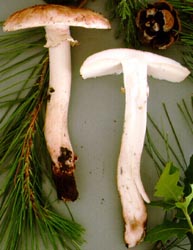
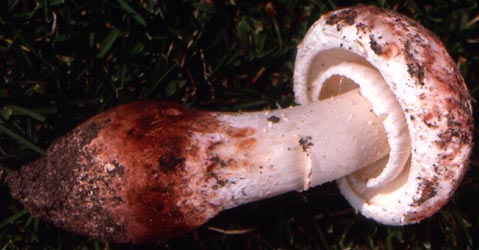
Amanita novinupta Tulloss & J. Lindgr.
Loc.: BC CA ID OR
Lit.: [Tulloss & Lindgren 1994]
Spores: [1477/73/42] (6.2-) 8.2 - 10.8 (-14.8) × (4.2-) 5.5 - 7.2 (-8.8) µm, (L = (8.1-) 8.6 - 10.2 (-11.0) µm; L’ = 9.3 µm; W = (5.5-) 6.0 - 6.8 (-7.2) µm; W’ = 6.3 µm; Q = (1.13-) 1.31 - 1.69 (-2.47); Q = (1.34-) 1.39 - 1.58 (-1.72); Q’ = 1.48).
[image]
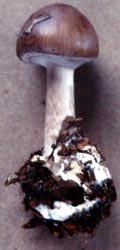
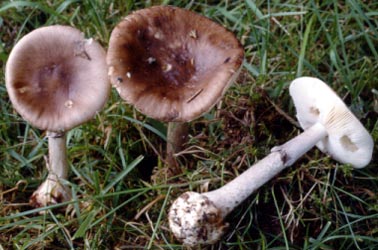
Amanita porphyria Alb. & Schwein. : Fr.
Loc.: CA OR WA
Lit.: [Arora 1986]
Spores: [137/7/5] (7.5-) 8.0 - 9.8 (-11.2) × (7.0-) 7.5 - 9.2 (-11.0) µm, (L = (8.5-) 8.6 - 8.9 µm;
L’ = 8.9 µm; W = (8.0-) 8.1 - 8.5 µm; W’ = 8.3 µm; Q = (1.0-) 1.02 - 1.12 (-1.26); Q = 1.05 - 1.07; Q’ = 1.06).
[image]

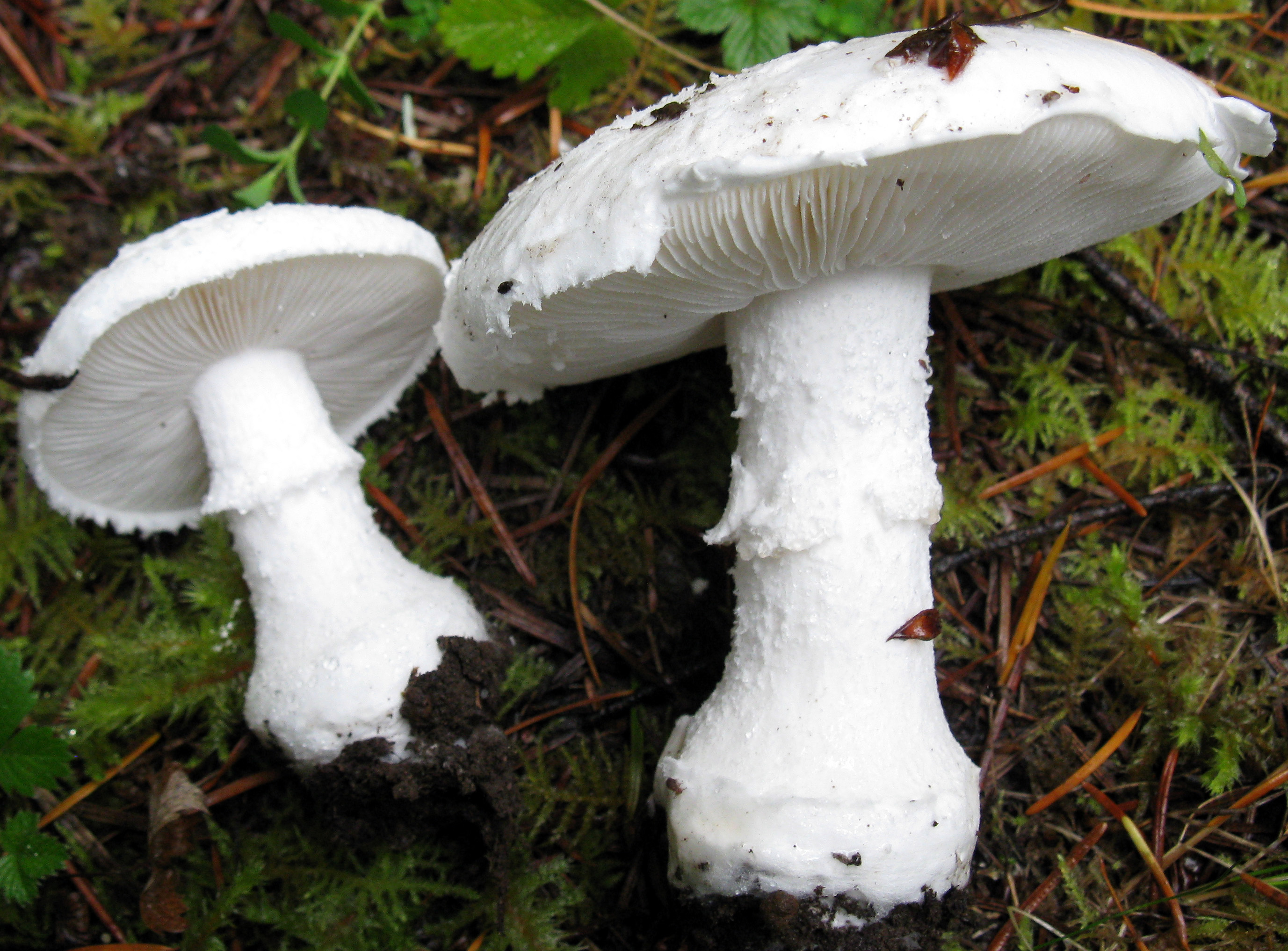
Amanita silvicola Kauffman
Loc.: CA OR WA
Lit.: [Bas 1969]
Spores: [203/10/8] (6.1-) 7.2 - 10.0 (-12.5) × (4.0-) 4.2 - 6.0 (-8.8) µm, (L = (7.5-) 8.0 - 9.2 µm; L' = 8.5 µm; W = 4.5 - 5.4 (-6.0) µm; W' = 5.1 µm; Q = (1.31-) 1.44 - 2.0 (-2.18) µm; Q = (1.52-) 1.62 - 1.83 µm; Q' = 1.69 µm).
[image]
Amanita sp. A. H. Sm. 73569
Loc.: ID
Lit.: [A. H. Sm. ms.]
Spores: “8-10 × 5-5.5 μ, smooth, ellipsoid, amyloid”; Q = approx. 1.7.
Pileus 70 mm wide, pallid with brownish disc; universal veil cinereous; context unchanging.
Amanita sp. A. H. Sm. 73798
Loc.: ID
Lit.: [A. H. Sm. ms.]
Spores: “7-9 (10) × 5-6 (7) μ, ellipsoid, smooth and amyloid”; Q = approx. 1.45.
Pileus 40-55 mm wide, near Cinnamon Buff on disc, paler and nearer ochraceous toward margin; context unchanging; universal veil
avellaneous tinged with yellow.
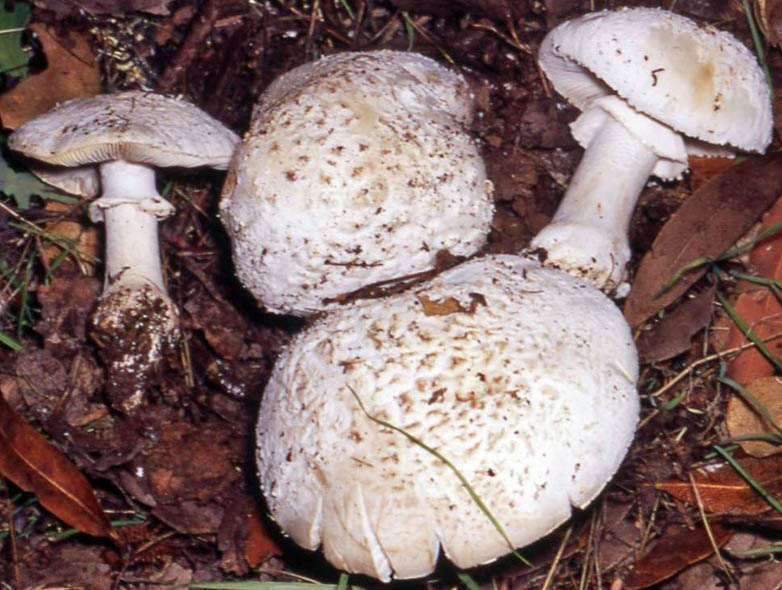
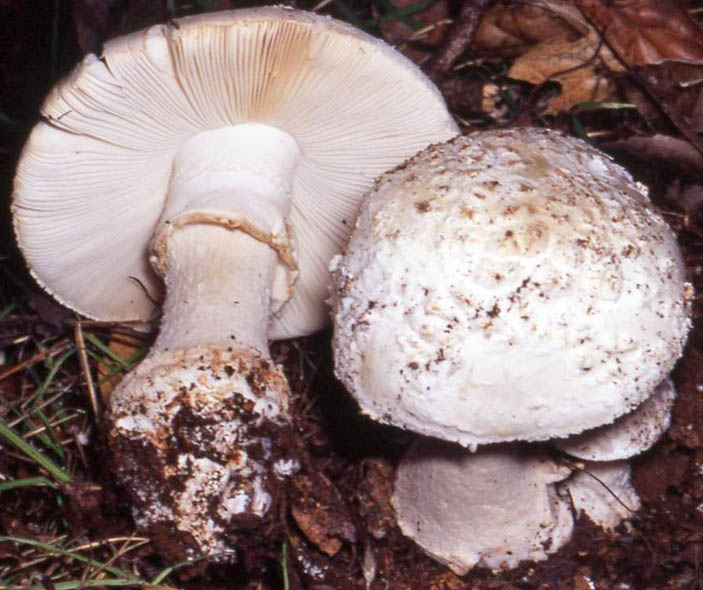
Amanita sp-C20
Loc.: CA
Spores: [40/2/1] (7.5-) 8.0 - 10.5 (-13.7) × 5.0 - 7.0 (-7.5) μm, (L = 9.2 μm; L' = 9.2 μm; W = 5.7 - 5.8 μm; W' = 5.7 μm; Q = (1.38-) 1.40 - 1.83 (-2.14); Q = 1.61 - 1.64; Q' = 1.62).
[image]
Amanita sp-NW10
Loc.: WA
Spores: [40/2/2] (6.0-) 6.9 - 10.5 (-11.0) × (5.2-) 6.6 - 10.0 (-10.2) µm, (L = 9.1 - 9.2 µm; L’ = 9.1 µm; W = 8.4 - 8.6 µm; W’ = 8.5 µm; Q = 1.03 - 1.16 (-1.19); Q = 1.07 - 1.08; Q’ = 1.07).
Pileus 30-40 mm wide, pale yellow to pale greenish yellow; universal veil as irregular white to brown patches or reddish brown fibrils.
Subgenus Lepidella (Spores amyloid. Species amycorrhizal)
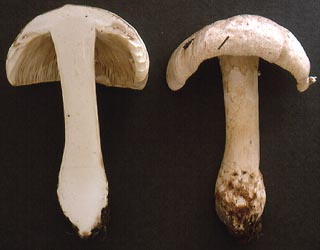
Amanita armillariiformis Trueblood & Dav. T. Jenkins in O. K. Mill., Trueblood & Dav. T. Jenkins
Loc.: ID OR
Lit.: [Mille., Trueb., & Jenki. 1990]
Spores: [260/13/4] (8.8-) 9.8 - 15.0 (-17.0) × (5.8-) 6.5 - 8.9 (-11.3) µm, (L = (10.4-) 10.6 - 13.4 µm; L’ = 12.3 µm; W = 6.7 - 7.8 (-8.3) µm; W’ = 7.5 µm; Q = (1.18-) 1.39 - 1.90 (-2.20); Q = (1.39-) 1.56 - 1.79; Q’ = 1.65).
[image]
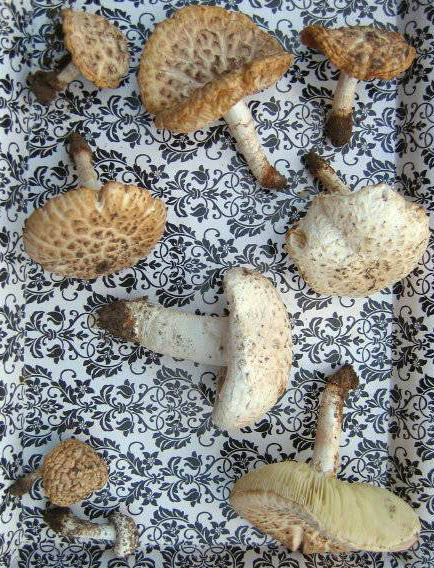
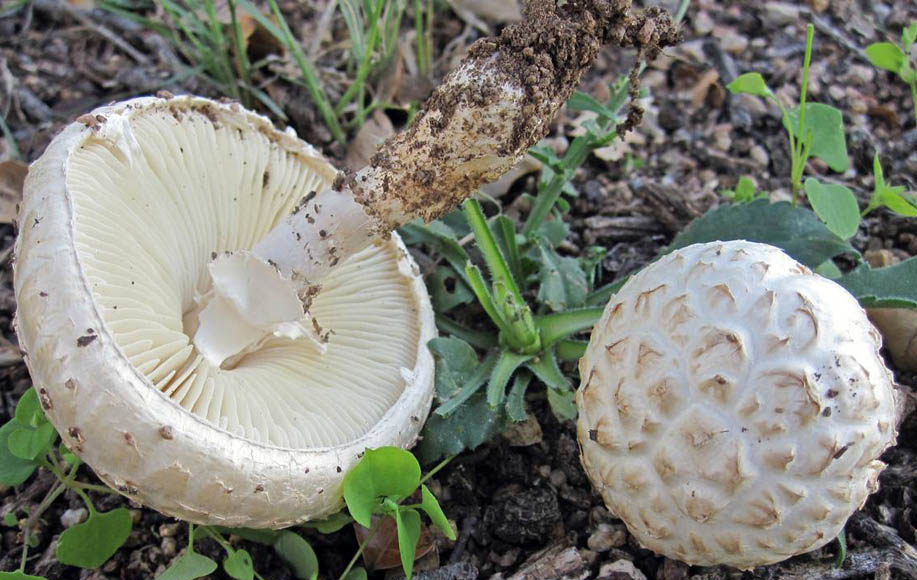
Amanita macerisolum Tulloss nom. prov.
Loc.: BCN CA
Spores: [140/7/5] (8.8-) 10.5 - 13.5 (-14.5) × (6.8-) 7.8 - 9.5 (-10.8) µm, (L = 11.5 - 12.7 µm; L’ = 12.0 µm; W = 8.3 - 8.9 µm; W’ = 8.5 µm; Q = (1.22-) 1.27 - 1.54 (-1.76); Q = 1.37 - 1.45; Q’ = 1.41).
[image]

Amanita prairiicola Peck
Loc.: OR
Spores: [700/34/11] (8.0-) 10.0 - 14.0 (-19.2) × (5.2-) 6.4 - 10.0 (-12.2) µm, (L = (10.4-) 11.0 - 13.3 (-13.7) µm; L’ = 12.0 µm; W = (6.5-) 6.6 - 9.6 (-9.7) µm; W’ = 8.0 µm; Q = (1.09-) 1.26 - 1.82 (-2.31); Q = (1.30-) 1.33 - 1.75 (-1.85); Q’ = 1.51).
[image]

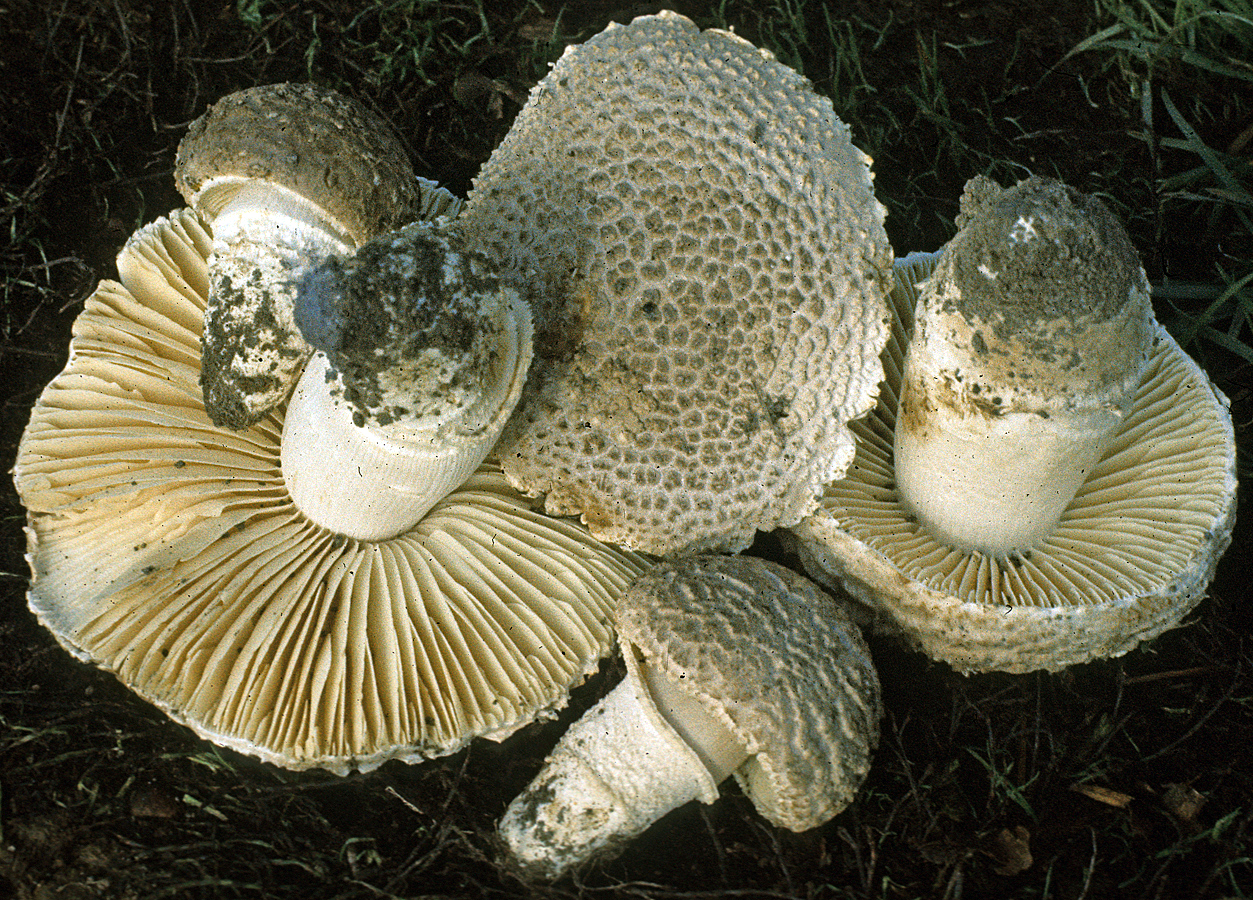
Amanita pruittii A. H. Sm. ex Tulloss, J. Lindgr. & Arora
Loc.: CA
Lit.: [Tull., Lindg., Arora, Wolfe, Rod.-Cay. 2014]
Spores: [551/26/8] (6.8-) 8.0 - 11.2 (-14.0) × (5.8-) 6.5 - 8.8 (-11.2) µm, (L = 8.7 - 10.3 µm; L’ = 9.4 µm; W = (6.9-) 7.1 - 8.0 (-8.1) µm; W’ = 7.5 µm; Q = (1.0-) 1.09 - 1.45 (-1.79); Q = (1.17-) 1.19 - 1.35 (-1.37); Q’ = 1.25).
[image]


Amanita subcaligata (A. H. Sm. & P. M. Rea) A. H. Sm. ex Tulloss in Volk & Burds.
Loc.: CA
Lit.: [Thiers 1957]
=Amanita salmonea.
Spores: [180/8/6] (8.5-) 9.3 - 13.0 (-17.7) × (6.2-) 6.5 - 10.2 (-11.5) µm, (L = 9.9 - 11.9 (-12.4) µm; L’ = 11.4 µm; W = (6.7-) 8.0 - 9.5 µm; W’ = 8.6 µm; Q = (1.05-) 1.14 - 1.54 (-1.93); Q = 1.22 - 1.44 (-1.48); Q’ = 1.33).
[image]
Not assigned to section
Amanita sp. Oswald 3
Loc.: OR
Lit.: [A. H. Sm. ms.]
Spores: “6-8 × 4-4.5 μm, ellipsoid, smooth, strongly amyloid”; Q = approx. 1.65.
Pileus 40-50 mm wide, pale pinkish buff, and glabrous. Smith reported bilateral divergent gill tramae and strongly amyloid spores but it cannot be placed into a section with the data available.
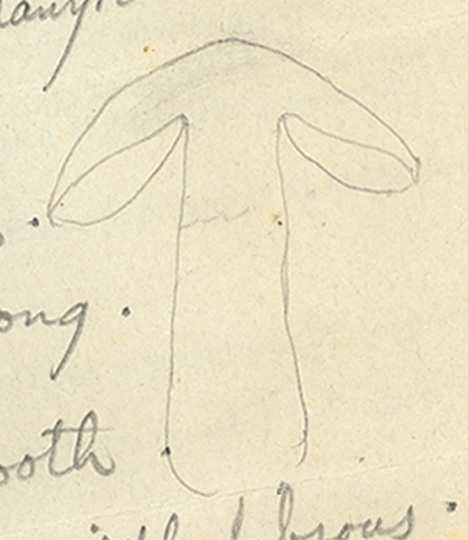
Limacella mcmurphyi Murrill
Loc.: CA
Lit.: [Murrill 1912]
Spores: [20/1/1] (3.5-) 4.5 - 5.5 (-6.0) × (3.0-) 3.4 - 4.3 (-4.5) μm, (L = 4.9 μm; W = 3.8 μm; Q = (1.12-) 1.13 - 1.44 (-1.56); Q = 1.30).
[image]
Limacella roseicremea Murrill
Loc.: WA
Lit.: [Murrill 1912]
Spores: [8/1/1] 4.5 – 6.2 × 3.5 – 4.5 µm, (L = 4.8 µm; L’ = 4.8 µm; W = 3.7 µm; W’ = 3.7 µm; Q = (1.21–) 1.22 – 1.43; Q = 1.30; Q’ = 1.30).
Pileus 25-60 mm wide, cream tinted with rose, glabrous and viscid.
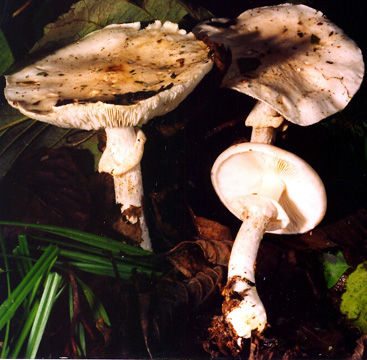
Limacella sp-Burnett-5-ix-1994
Loc.: WA
Spores: [60/3/1] (4.1–) 4.3–6.0 (–7.2) × (3.2–) 3.4–4.6 (–5.5) µm, (L = 5.0–5.2 µm; L’ = 5.2 µm; W = 3.9–4.2 µm; W’ = 4.0 µm; Q = (1.06–) 1.09–1.53 (–1.94); Q = 1.26–132; Q’ = 1.30).
[image]

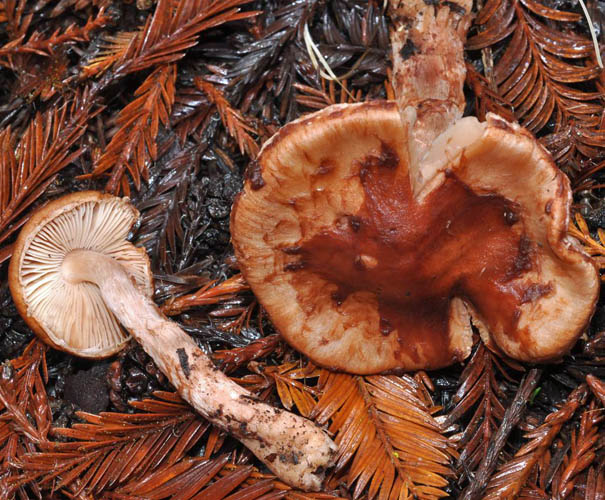
Limacella sp-L-CA01
Loc.: CA
[image]

Limacella sp-Pastorino-3-9-06-A-B
Loc.: CA
Pileus 28-39 mm wide, beige to beige-tan with scattered dark reddish spots and a broad smooth umbo.
[image]

Limacella sp-Krstic-20-xi-2010
Loc.: WA
Spores: [10/1/1] 4.5 - 5.0 (-5.8) × 3.3 - 4.5 (-5.2) μm, (L = 4.7 μm; W = 4.1 μm; Q = 1.09 - 1.32 (-1.36); Q = 1.17).
[image]

Limacella sp-Krstic-27-vi-2010
Loc.: WA
Spores: [5/1/1] 4.8 - 7.2 × 4.0 - 6.0 μm, (L = 5.7 μm; W = 4.9 μm; Q = 1.09 - 1.20; Q = 1.17).
[image]


Limacella sp-L-OR01
Loc.: OR WA
Pileus 48-70 mm wide, red-brown.
[image]
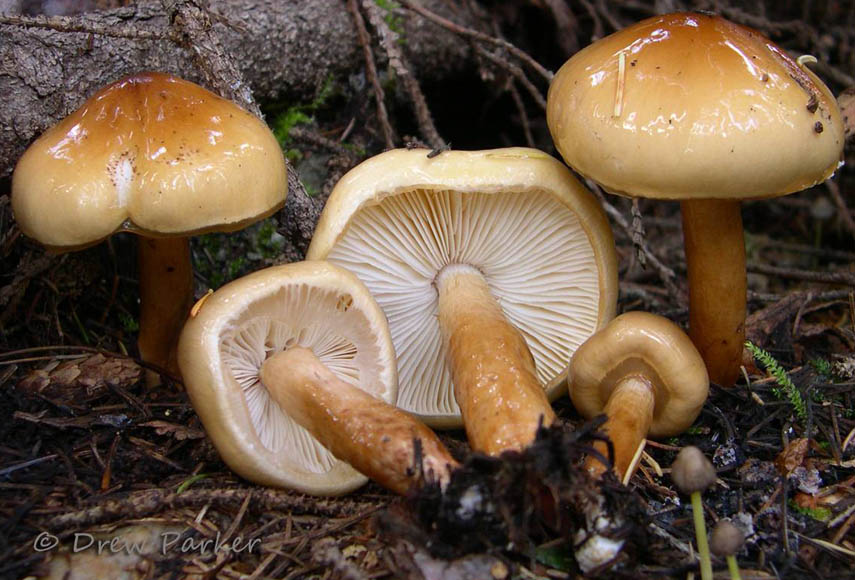
Limacella sp-L-WA01
Loc.: WA
[image]
BIBLIOGRAPHY
[Arora 1986] Arora, D. 1986. Mushrooms demystified. 2nd ed.
(Ten Speed Press, Berkeley). 959 pp.
[Ayala, Manja., Guzmán., & Thier. 1988] Ayala, N., I. Manjarrez, G. Guzmán, H. D.
Thiers. 1988. Los hongos de la Peninsula de Baja California, III. Las
especies conocidas del genero Amanita. Rev. Mex. Micol. 4: 69-74.
[Bas 1969] Bas, C. 1969. Morphology and subdivision of Amanita and a monograph of its section Lepidella. Persoonia 5: 285-579.
[Bojantchev & Davis 2013] Bojantchev, D. and R. M. Davis. 2013. Amanita augusta, a new species from California and the Pacific Northwest. N. Amer. Fungi 8(5): 1-11. [23 April 2013] http://www.pnwfungi.org/pdf_files/manuscripts_volume_8/naf20135.pdf
[Bojan., Penny., & Davis 2011] Bojantchev, D., S. R. Pennycook and R. M. Davis. 2011. Amanita vernicoccora sp. nov.—the vernal fruiting "coccora" from California. Mycotaxon 117: 485-497.
[Breckon thesis] Breckon, G. J. 1968. A taxonomic survey of the
genus Amanita in northern California. M.S. thesis. (San Francisco State
College). iv+143 pp.
[Cripps & Lindgren 2017] Cripps, C. and J. E. Lindgren. 2017. Amanita alpinicola sp. nov., associated with Pinus albicaulis, a western 5-needle pine. Mycotaxon 132(3): 665-676.
[Geml, Tull., Laur. Sazan. & Tayl. 2008] Geml, J., R. E. Tulloss, G. A. Laursen, N. A. Sazanova and D. L. Taylor. 2008. Evidence for strong inter- and intracontinental phylogeographic structure in Amanita muscaria, a wind-dispersed ectomycorrhizal basidiomycete. Molec. Phylog. Evol. 48: 694-701.
[Gminder 1994] Gminder, A. 1994. Die trockenstieligen Arten der Gattung Limacella in Europa. Z. Mykol. 60(2): 377-398.
[Jenkins 1977] Jenkins, D. T. 1977. A taxonomic and nomenclatural study of the genus Amanita section Amanita for North America. Biblioth. Mycol. 57: 126 pp.
[Jenkins 1978] Jenkins, D. T. 1978b. A study of Amanita types II. A. ocreata Peck. Mycotaxon 7: 371-372.
[Jenkins 1979] Jenkins, D. T. 1979. A study of Amanita types. III. Taxa described by W. A. Murrill. Mycotaxon 10: 175-200.
[Jenkins 1982] Jenkins, D. T. 1982. A study of Amanita types IV. Taxa described by G. F. Atkinson. Mycotaxon 14: 237-246.
[Mille., Trueb., & Jenki. 1990] Miller, O. K., Jr., E. Trueblood, and D. T. Jenkins. 1990. Three new species of Amanita from Southwestern Idaho and Southeastern Oregon. Mycologia 82(1): 120-128.
[Murrill 1912] Murrill, W. A. 1912a. The Agaricaceae of the Pacific Coast—I. Mycologia 4: 205-217.
[Nakamura thesis] Nakamura, N. 1965. A survey of Amanita in western Washington. M.S. thesis, Univ. Washington. v+100 pp., 22 pls.
[A. H. Sm. ms.] Smith, A. H. unpub. Amanita Manuscript. in MICH. [Courtesy of Dr. Nancy Smith Weber]
[Thiers 1947] Thiers, H. D. 1957. The Agaric flora of Texas. I. New species of agarics and boletes. Mycologia 49: 707-722.
[Thiers & Ammirati 1982] Thiers, H. D. and J. F. Ammirati, Jr. 1982. New species of
Amanita from western North America. Mycotaxon 15: 155-166.
[Thiers 1982] Thiers, H. D. 1982. The Agaricales of California.
1. Amanitaceae, (Mad River, Eureka). pp. + unnumbered plates.
[Tulloss & Wright 1989] Tulloss, R. E. and G. Wright. 1989. Amanita protecta—a new species from coastal Southern California. Mycotaxon 34: 615-622.
[Tulloss & Lindgren 1992] Tulloss, R. E. and J. E. Lindgren. 1992. Amanita smithiana—taxonomy, distribution, and poisonings. Mycotaxon 45: 373-387.
[Tulloss 1994] Tulloss, R. E. 1994. Type studies in Amanita section Vaginatae I: Some taxa described in this Century (studies 1-23) with notes on description of spores and refractive hyphae in Amanita. Mycotaxon 52: 305-396.
[Tulloss & Lindgren 1994] Tulloss, R. E. and J. E. Lindgren. 1994. Amanita novinupta—a rubescent, white species from the western United States and southwestern Canada. Mycotaxon 51: 179-190.
[Tulloss & Moses 1995] Tulloss, R. E. and E. Moses. 1995. Amanita populiphila—a new species from the central United States. Mycotaxon 53: 455-466.
[Tulloss 1998] Tulloss, R. E. 1998c. Amanita prairiicola—alive and well and living under an assumed name. Kansas Mycolog 13.4(73): 1-5.
[Tulloss & Lindgren 2005] Tulloss, R. E. and J. E. Lindgren. 2005. Amanita aprica—a new toxic species from western North America. Mycotaxon 91: 193-205.
[Tulloss 2009] Tulloss, R. E. 2009. Amanita magniverrucata—revision of an interesting species of Amanita section Lepidella. Mycotaxon 108: 93-104.
[Tull., Lindg., Arora, Wolfe, Rod.-Cay. 2014] Tulloss, R. E., J. E. Lindgren, D. Arora, B. E. Wolfe and C. Rodríguez-Caycedo. 2014. Amanita pruittii—a new, apparently saprotrophic species from US Pacific coastal states. Amanitaceae 1(1): 1-9.
[G. Wright ms.] Wright. G. Southern California Mushrooms Manuscript [Courtesy G. Wright]